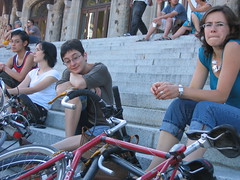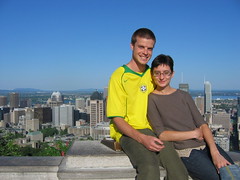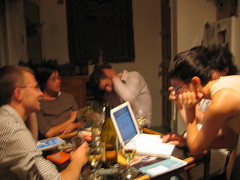Chicago to Madison
We arrived in Chicago on Sunday, July 24. Stayed with the Minshells—my father’s cousin Rich and his wife Marcie, along with their three children Olivia (Ollie, 12), and Jack and Dave (twins, 3)—in a suburb called La Grange Park. Friday afternoon drank beer on the deck in sweltering 100-degree heat and watched the boys fight for each other’s lives on a picnic table pirate ship against an evil squid that lived in the ocean below the deck. On Saturday, we picked up a guide to the USA while waiting out a rainstorm at the train station, then headed into downtown just as it cleared. Union Station lets off just west of the Sears Tower, and the Chicago Board of Trade, which lives in serious-whimsical Art Deco building that you are no longer able to tour (much to our chagrin, as we had planned to watch the commodities trading floor, where over 50% of the world’s grain stock is bought and sold). We sauntered past these landmarks on our way to the meeting site for a walking tour of the “historical skyscrapers” in Chicago, led by the city’s Architectural Foundation. “Historical” turns out to mean “built between 1871 and 1934”. In 1871, “the great fire” wiped out 17,000 buildings downtown and left it a tabla raza for the new architects—who had discovered the wonders of the steel frame building bridges during the Civil War. By the early 30s, the depression had halted new building completely, and it didn’t resume until after WWII, by which time architecture had presumably changed quite a bit. In any case, it was a typically long (and at times long-winded) walk, but we learned all of the above and got to see some real monuments to human industry along the way. Chicago had also just opened a new public space called Millennium Park, which features beautiful gardens (and a strange-ish sort of woodland area), an outdoor pavilion that nestles under the skyline and was designed by Frank Gehry, and an outdoor exhibit of aerial photos of the city. There’s also an incredibly fountain. It’s composed of two facing 20-feet towers made of glass brick. Water flows overtop the brick to the ground below, and while simultaneously giant images of human faces are projected on a screen under the brick (they smile, blink, and sometimes making a kissing face that somehow inspires water to shoot out of their lips). There’s no fountain basin—the water just tumbles onto the marble slabs below, and the children rush to the base of the towers to feel the waterfall over their heads or splash on the ground in the two inches of water that is allowed to collect before it flows over an miniature edifice to be recycled back into the waterfall. The whole public space had an inclusive feel to it.
We loved Chicago. It felt livable. Bustling, but quite and clean, not buckling at the knees from so much worry and strife.
On Tuesday we left and headed out of town via the University of Chicago, taking “back roads” through South Chicago. It’s a strange thing to be driving under the L tracks with projects on either side, buttressed only by large and empty (but for some reason fenced-in) lots and then to emerge into the campus—tree-lined streets, orderly bustle, and lots of white people. In any case, we where slightly underwhelmed by the campus and the severe gothic buildings, which looked like something out of a children’s horror story. It was a brief stop, and after finding that there is no central graduate studies office or student affairs center, we left. Passing through about four hours worth of suburbs, we began to realize that the uncontrollable shaking that the car was doing might be a problem. We found a Firestone and $500 and three hours later, we had new front tires, alignment, et al. Getting late in the day now, we thought we could get as far as Madison, camp for the night, and do a little tour of the area the following day.
We camped at Lake Kegonda – a beautiful state park, with spacious set-back camp sites and a 360-acre lake, sitting in the middle of a vast expanse of lush green farmland. Only 200 years of human industry have transformed the landscape into a different beast altogether. All that corn, which seems immovable, were trees that we just peeled back like sunburned skin.
Scheduled today: the University of Wisconsin at Madison campus, Devil’s Lake State Park, and Baraboo—home of Circus World.
[Note: We’ve skipped describing Cleveland, where we saw an amazing exhibition of a new mummification technique called plastination. The exhibit is (unfortunately) called BodyWorlds 2. In case we don't get to writing about it, everyone should check out the website. It's madness.
We loved Chicago. It felt livable. Bustling, but quite and clean, not buckling at the knees from so much worry and strife.
On Tuesday we left and headed out of town via the University of Chicago, taking “back roads” through South Chicago. It’s a strange thing to be driving under the L tracks with projects on either side, buttressed only by large and empty (but for some reason fenced-in) lots and then to emerge into the campus—tree-lined streets, orderly bustle, and lots of white people. In any case, we where slightly underwhelmed by the campus and the severe gothic buildings, which looked like something out of a children’s horror story. It was a brief stop, and after finding that there is no central graduate studies office or student affairs center, we left. Passing through about four hours worth of suburbs, we began to realize that the uncontrollable shaking that the car was doing might be a problem. We found a Firestone and $500 and three hours later, we had new front tires, alignment, et al. Getting late in the day now, we thought we could get as far as Madison, camp for the night, and do a little tour of the area the following day.
We camped at Lake Kegonda – a beautiful state park, with spacious set-back camp sites and a 360-acre lake, sitting in the middle of a vast expanse of lush green farmland. Only 200 years of human industry have transformed the landscape into a different beast altogether. All that corn, which seems immovable, were trees that we just peeled back like sunburned skin.
Scheduled today: the University of Wisconsin at Madison campus, Devil’s Lake State Park, and Baraboo—home of Circus World.
[Note: We’ve skipped describing Cleveland, where we saw an amazing exhibition of a new mummification technique called plastination. The exhibit is (unfortunately) called BodyWorlds 2. In case we don't get to writing about it, everyone should check out the website. It's madness.



